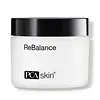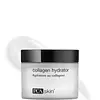What's inside
What's inside
 Key Ingredients
Key Ingredients

 Benefits
Benefits

 Concerns
Concerns

 Ingredients Side-by-side
Ingredients Side-by-side

Water
Skin ConditioningEthylhexyl Isononanoate
EmollientGlycereth-26
HumectantButylene Glycol
HumectantHydroxyethyl Acrylate/Sodium Acryloyldimethyl Taurate Copolymer
Emulsion StabilisingPhenoxyethanol
PreservativeNiacinamide
SmoothingCarbomer
Emulsion StabilisingPolyisobutene
Caprylyl Glycol
EmollientBisabolol
MaskingSodium Hydroxide
BufferingEthylhexylglycerin
Skin ConditioningHexylene Glycol
EmulsifyingPEG-7 Trimethylolpropane Coconut Ether
EmulsifyingTocopheryl Acetate
AntioxidantOenothera Biennis Oil
EmollientBorago Officinalis Seed Oil
EmollientAloe Barbadensis Leaf Juice
Skin ConditioningSodium Hyaluronate
HumectantWater, Ethylhexyl Isononanoate, Glycereth-26, Butylene Glycol, Hydroxyethyl Acrylate/Sodium Acryloyldimethyl Taurate Copolymer, Phenoxyethanol, Niacinamide, Carbomer, Polyisobutene, Caprylyl Glycol, Bisabolol, Sodium Hydroxide, Ethylhexylglycerin, Hexylene Glycol, PEG-7 Trimethylolpropane Coconut Ether, Tocopheryl Acetate, Oenothera Biennis Oil, Borago Officinalis Seed Oil, Aloe Barbadensis Leaf Juice, Sodium Hyaluronate
Water
Skin ConditioningC12-15 Alkyl Benzoate
AntimicrobialGlycerin
HumectantGlyceryl Stearate
EmollientCetearyl Alcohol
EmollientIsopropyl Palmitate
EmollientButyrospermum Parkii Butter
Skin ConditioningCyclopentasiloxane
EmollientDimethicone
EmollientCetyl Alcohol
EmollientPolysorbate 60
EmulsifyingTetrahexyldecyl Ascorbate
AntioxidantAllantoin
Skin ConditioningAloe Barbadensis Leaf Extract
EmollientChamomilla Recutita Flower Extract
MaskingCucumis Sativus Fruit Extract
EmollientEthylhexylglycerin
Skin ConditioningGlycol Distearate
EmollientHelianthus Annuus Seed Oil
EmollientHydrolyzed Wheat Protein
Skin ConditioningOlea Europaea Fruit Oil
MaskingPhenoxyethanol
PreservativePotassium Cetyl Phosphate
EmulsifyingPrunus Amygdalus Dulcis Oil
Skin ConditioningSodium Hyaluronate
HumectantSodium PCA
HumectantTocopherol
AntioxidantXanthan Gum
EmulsifyingCarbomer
Emulsion StabilisingSodium Hydroxide
BufferingTetrasodium EDTA
Water, C12-15 Alkyl Benzoate, Glycerin, Glyceryl Stearate, Cetearyl Alcohol, Isopropyl Palmitate, Butyrospermum Parkii Butter, Cyclopentasiloxane, Dimethicone, Cetyl Alcohol, Polysorbate 60, Tetrahexyldecyl Ascorbate, Allantoin, Aloe Barbadensis Leaf Extract, Chamomilla Recutita Flower Extract, Cucumis Sativus Fruit Extract, Ethylhexylglycerin, Glycol Distearate, Helianthus Annuus Seed Oil, Hydrolyzed Wheat Protein, Olea Europaea Fruit Oil, Phenoxyethanol, Potassium Cetyl Phosphate, Prunus Amygdalus Dulcis Oil, Sodium Hyaluronate, Sodium PCA, Tocopherol, Xanthan Gum, Carbomer, Sodium Hydroxide, Tetrasodium EDTA
Ingredients Explained
These ingredients are found in both products.
Ingredients higher up in an ingredient list are typically present in a larger amount.
Carbomer is a polymer of acrylic acid. Its main role is to create a gel consistency.
A high amount of carbomer can cause pilling or balling up of products. Don't worry, most products contain 1% or less of carbomer.
Ethylhexylglycerin (we can't pronounce this either) is commonly used as a preservative and skin softener. It is derived from glyceryl.
You might see Ethylhexylglycerin often paired with other preservatives such as phenoxyethanol. Ethylhexylglycerin has been found to increase the effectiveness of these other preservatives.
Phenoxyethanol is a preservative that has germicide, antimicrobial, and aromatic properties. Studies show that phenoxyethanol can prevent microbial growth. By itself, it has a scent that is similar to that of a rose.
It's often used in formulations along with Caprylyl Glycol to preserve the shelf life of products.
Sodium Hyaluronate is hyaluronic acid's salt form. It is commonly derived from the sodium salt of hyaluronic acid.
Like hyaluronic acid, it is great at holding water and acts as a humectant. This makes it a great skin hydrating ingredient.
Sodium Hyaluronate is naturally occurring in our bodies and is mostly found in eye fluid and joints.
These are some other common types of Hyaluronic Acid:
Learn more about Sodium HyaluronateSodium Hydroxide is also known as lye or caustic soda. It is used to adjust the pH of products; many ingredients require a specific pH to be effective.
In small amounts, sodium hydroxide is considered safe to use. However, large amounts may cause chemical burns due to its high alkaline.
Your skin has a natural pH and acid mantle. This acid mantle helps prevent harmful bacteria from breaking through. The acid mantle also helps keep your skin hydrated.
"Alkaline" refers to a high pH level. A low pH level would be considered acidic.
Learn more about Sodium HydroxideWater. It's the most common cosmetic ingredient of all. You'll usually see it at the top of ingredient lists, meaning that it makes up the largest part of the product.
So why is it so popular? Water most often acts as a solvent - this means that it helps dissolve other ingredients into the formulation.
You'll also recognize water as that liquid we all need to stay alive. If you see this, drink a glass of water. Stay hydrated!
Learn more about Water